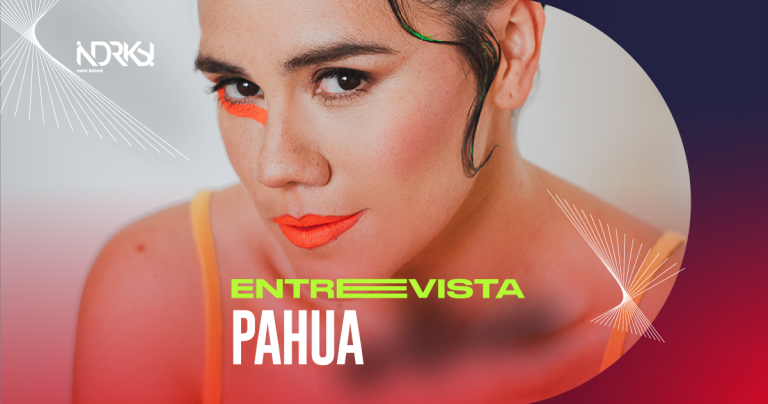Femininity, discipline and talent, represented in a mix of Latin rhythms that—even if you don’t want to—will make you move your body.
We had the opportunity to talk with Paulina Sotomayorthe mind behind the concept Pahua, a project that has given rise to a series of collaborations and opportunities that make it clear that, by combining love and talent, great things can be achieved.
On the occasion of his next tour around the Mexican Republic and his recent participation in the Pepsi Center WTC of CDMX, where he had the opportunity to open the Show of Hozier, Pahua It is a sign that although the talent is clear, it does not exempt her from constant work and the nervousness of knowing herself to be selected among other talents.
The selection was very interesting because there were 10 projects that were being considered for this show and then there were five, then three and, in the end, they ended up selecting Pahuaeven though the music is very different from that of Hozier. I feel like there’s a very different openness to music lately and whenever you open the Show from another artist, the reception is good, so I was super excited.”
If something has characterized Paulina Sotomayor, is its essence and fidelity to Latin rhythms and percussions. Taking into account that in these times some artists choose to experiment with fashionable genres, we wanted to know what line and under what context it will be developed. Pahua in the music.
For some time now I’ve been listening to a lot of global music, between global bass and tropical music. I love the music of the Colombian Pacific, rhythms like cumbia, from Mexican, Colombian, Argentine and Peruvian. I really like the music I’ve made lately because all these rhythms are present, also dembow, a bit of dancehall and South American folklore. I have had the opportunity to work with several collaborators in different territories and that has contributed a lot to the music because, when you have your music and you pass it into the hands of someone else, it begins to explore other rhythms and ends up being music that has rhythms of each one of the regions.”
Determined to continue breaking cultural barriers through the universal language of music and, with the intention that everyone who listens to Pahua remains with a very characteristic seal of the concept, she shares with us the importance of meeting the right people at the right time, since – without imagining it – it would be the mother of one of her friends who helped reflect this entire concept in the wardrobe. , something that has made it a way to identify it in each country that has been presented.
Right now I’m teaming up with Carmen Rion, a Mexican designer who makes clothes that are a little more elegant, but has been adapting different jumpsuits and jumpers, for all my presentations. She makes many things with different Mexican textiles and made me a jumpsuit one that is like a leopard, another that has very pretty flowers and different strange spectrums. It’s really cool to work with her. It just so happens that her daughter is my friend for many years and at some point I went to eat with her at her house and she told me: ‘hey, it would be great if I could dress you for your shows and that we make you things that are more tailored so that you can feel comfortable with those clothes’ and the truth is that I feel very comfortable and I feel that it is an important hallmark to have that type of style. I love it because there is no occasion where they don’t make some comment about my wardrobe and hairstyle. I just went to Europe last year and they gave me different costumes, one of them was super pretty because it was just like black and white, like it was a medieval dress but adapted to the tropical, very cool. I feel like I get on very well with her and it’s always something that looks very nice on stage and that’s always very enjoyable, right?”
Totally agree with Paulsince his presentations are a visual treat, between the costumes, the visual representations and the mix of rhythms, which with the collaborations he has achieved, has given an important nuance to his music. Dwells It is a clear example that the union of strength and talent opens a world of opportunities and, above all, that of meeting other artists.
Most of the artists that are on the album have been friends that I have met during the growth process, others I met through the label and many others I contacted by email ‘hey, this is my new music, I want to see if they listen to it’ and the truth is I was lucky that everyone liked it, only with one artist it didn’t happen because he was on tour.”
Wanting is power and for Pahuaneither distance nor pandemic times have been impediments to its development, not only have work ties been made with several artists, but they have also achieved a community that, without a doubt, is reflected when listening to their creations .
I worked mostly digitally with all of them, but with many I had the opportunity for them to come to Mexico and we recorded things in the studio. The truth is that it has been really cool because it’s not just the collaboration, you actually end up becoming your friends and I feel like that makes the experience complete. From this album I have been able to travel to different regions and we do shows together, either I stay at their house or they stay at my house, so we end up making a very nice friendship.”
For Pahua It is very important to respect the essence of each artist, thus ensuring that each of the songs preserve the authenticity of the different nationalities, under a more feminine concept and involved with nature. Dwells is a clear example of this.
This album has super varied music and you can feel in each of the songs that they were thought of as: ‘well, if this artist is Colombian, let it maintain a Colombian essence with Mexico’ and ‘if this artist is Chilean, then the bohemian thing will be maintained.’ -Mexican, but that has the South American part in the rhythm. It is also more feminine and has very feminine collaborations, I had the opportunity to work with a lot of women and it is really cool because it changes the process a lot, from what you talk about, how you approach it, what is the romantic part of each one of the songs. All of that has contributed a lot to each of the songs and the project in general.”
From decision making, selection of the work team, various collaborations and generating an environment in which everyone is comfortable, Paul He shares with us a little about the organization he runs with his work team and how it influences his success.
It has been a challenge for me because when you have a musical project and really want to make a living from music, you have to cover a lot of areas, from the way you communicate your music, what presentations you want to have, how you you want to present, how you express yourself, it’s all work. I am also fortunate that I can work with a team in Mexico, I also have an agency that is helping me in the United States and Canada and another agency that is in Europe. It’s different when you have a whole work team, than when you do everything alone because sometimes you think: ‘I can do it alone, I do everything alone’ and it’s like ‘no, no, it can’t be done’, you need people who are also in your work team and that I can contribute different things and that you can delegate. The truth is that up to this point, it has worked super well, I love the way the project has grown.”
However, and like every human being, it is necessary to create a space that takes you out of the routine to maintain a healthy mind so that ideas flow; walking with your dog is one of the activities that Paul He does it constantly since, during each walk, the constant contact with nature nourishes this creativity. As a curious fact, she shared with us that she enjoys saving voice notes with different environmental sounds, from the song of a bird to the sound of a traffic light on the street.
Pahua It has dates scheduled for Guadalajara, CDMX, Oaxaca, Pachuca, Aguascalientes, Torreón, during the coming months; The enthusiasm of touring the Mexican Republic is evident, however, when we asked him what date he was most excited about, this is what he answered.
“The one from Guadalajara that is PortAmerica, I was very excited because it is going to be a participation with an artist that I admire a lot, who is Nidia Góngora, she is a Colombian artist who makes incredible music, she uses a lot of marimbas, a lot of drums that she chose from the region. Her mother was a super important character for the Choco community, which is a community in the Pacific and they have this super beautiful roots music and the lyrics are very deep, they talk a lot about this super feminine part of her, of the community, how to make a team. Her music is super cool and I’ve always dreamed of having a collaboration with her and now that they invited me to be part of her presentation it was like ‘wow I really want to do it!’ and it is a super important festival that links gastronomy with music that is super well curated and all this goes hand in hand with the most important music fair in Latin America, which is FIM GDL, where many people from different regions of the world come together from Senegal, Kenya, people come from the Middle East, a lot of very international music comes and what better than to do it in Mexico and have the opportunity to meet new musicians and even more so now that Mexico has a range super awesome concert. “It’s super cool to see how Mexico has grown in the music industry.”
Shows full of surprises, guest artists, dedicated planning, with love and always looking for the best to offer on stage could not be achieved without the magic of Julia, an Argentine girl who—for several years—has lived in Mexico and is the one in charge of landing all the ideas of Pahua and materialize them in the visuals that we can see on stage.
We have tried in each of the songs to break down the concept to know exactly what can be used, one of the songs talks about a bird, so we look for a little bird that is from New Guinea that is dancing. For example, I have a video that I made for the ‘Scarecrow’ song that is a boy who is dancing but who has a mask that is made in Guerrero with straw and rope and he looks divine and we adapt all of that to the Show.”
We leave you the dates and cities where you can enjoy the talent and versatility of PahuaDon’t forget to follow her on social networks (@pahuamusic) so you don’t miss out on the surprises that are coming.






